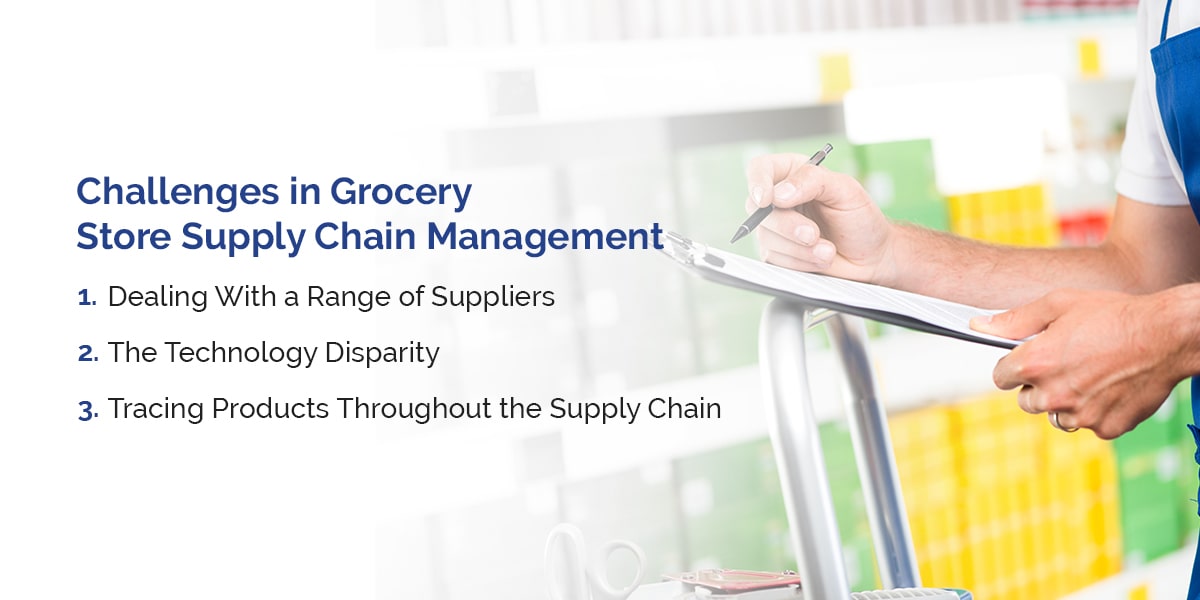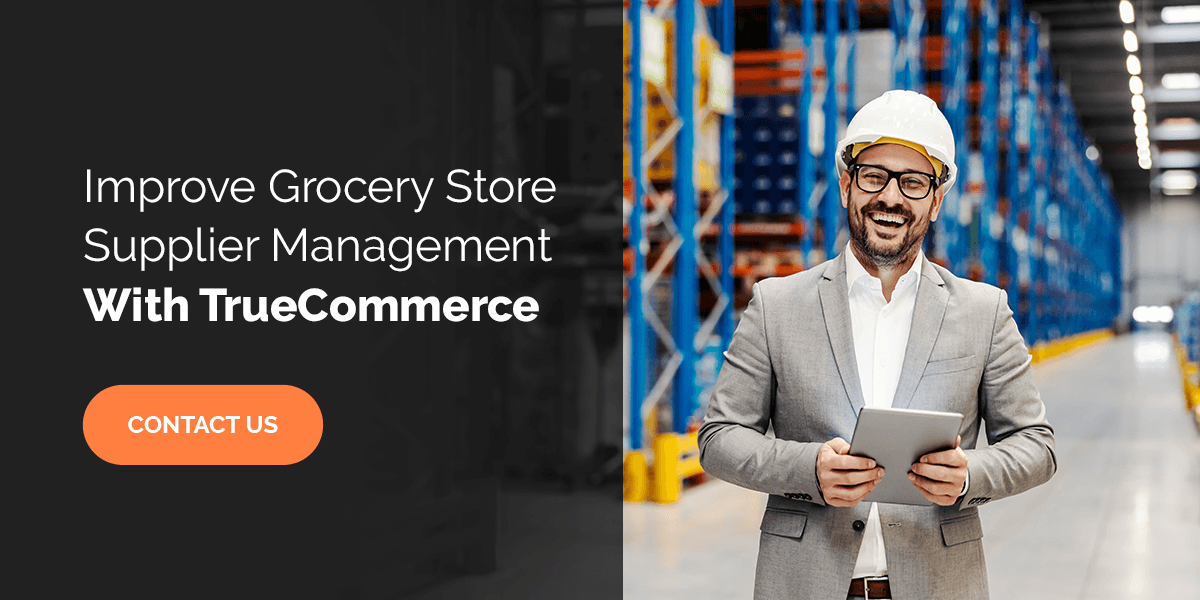Why Supplier Management Matters for Grocery Growth

January 20, 2023
Food has always been essential, but as the number of people buying groceries online skyrockets, grocery stores have become pivotal in helping the American public to stay healthy and nourished at home. The exponentially increased demand for household items, food staples, and care products has required the grocery industry to reevaluate and revamp every part of its supply chain, from procurement and order processing to fulfillment and supplier management. These major shifts have affected retailers, manufacturers, distributors, and grocery store supply chain managers.
The grocery ecosystem thrives on collaboration between retail stores like Kroger, Walmart, and Wegmans, and the huge number of vendors who make the products on the shelves. With so many vendors to work with, grocery store supply chain managers need to be adept at connecting with partners of all sizes, maturities, and technological capabilities.
In the current climate, it’s more important than ever that IT directors and supply chain managers use strategies to improve grocery supply chain management and oversee products coming from multiple suppliers and vendors.
What Is Supplier Management?
Supplier management is the process by which a customer, like a grocery store, effectively communicates and transacts with their suppliers. The concept is incredibly broad, covering every aspect of the supplier-customer relationship, including tracking and optimizing supply chain processes and suppliers. Supplier management is crucial for grocery stores since they carry a wide selection of products, making the grocery supply chain a complicated one.
In this context, supplier management refers to the responsibility of the customer to provide clear guidelines and communication methods for transactions. The idea goes hand-in-hand with supplier enablement, which speaks to the ability of a customer to use connectivity and technology to boost collaboration and transaction efficacy. Essentially, supplier enablement gives your partners the tools they need to trade with you, while supplier management helps you communicate your needs with ease.
Challenges in Grocery Store Supply Chain Management
Supply chain managers face several challenges when trying to manage grocery suppliers. Here are a few of the most common difficulties grocery store supply chain managers may encounter as they try to optimize their supplier management:
1. Dealing With a Range of Suppliers
Grocery stores handle a huge diversity of products, the vast majority of which come from outside suppliers. Yes, some chains have their “store brand,” which is helpful for creating buyer loyalty and driving competitive prices. And of course, there are well-known brands on the shelves, like King’s Hawaiian rolls, Dannon yogurts, and Cottonelle toilet paper.
Along with these pillars of industry, grocery stores are also trading with startups, mom and pop businesses, and other SMBs. While these products are necessary to provide the product diversity customers crave and space for innovation and new products, having more suppliers makes it more difficult to manage inventory, orders, and transactions and limit spoilage and waste.
2. The Technology Disparity
Suppliers and vendors operate with varying degrees of technological proficiency. Leveraging technology is essential for IT directors and supply chain managers eager to optimize their grocery supply chain. For example, EDI is a popular form of automation that helps businesses to standardize, track, and process transactions. Larger institutions use EDI to accelerate order processing and scale their businesses to work with a multitude of partners and handle huge order volumes.
Yet startups may be far more limited in their technological capabilities than established omnichannel retailers. A smaller supplier, especially one that is newer to the market, may lack the technical sophistication to implement a comprehensive EDI solution. Instead, they may be sending order confirmations, invoices, bills of lading, and other documents by email or even fax, slowing down operations and wasting valuable time.
3. Tracing Products Throughout the Supply Chain
The United States Food and Drug Administration (FDA) launched new food traceability requirements in November 2022 as part of the Food Safety Modernization Act (FSMA). The rule requires any company that manufactures, processes, packs, or holds foods on the Food Traceability List to maintain records for certain critical tracking events (CTEs) in the food supply chain. While the deadline for compliance is in early 2026, many grocery stores and their grocery supply chain partners are already seeking ways to improve food traceability.
Increased visibility is valuable for every party involved in the grocery supply chain, from manufacturers and shipping partners to grocery stores and customers. Yet true whole-chain visibility is difficult to achieve. Several challenges can arise at any point in the supply chain to make product tracking difficult, from shipping delays to suppliers expanding into omnichannel markets. While the FDA’s new initiative will increase customer confidence in food quality and help businesses grow, it also poses a challenge to those unfamiliar with product traceability technology and automation.
As businesses look to comply with this new rule, transparency in the food and beverage supply chain becomes even more critical. Grocery stores that keep manual records will find it difficult to ensure their accuracy and send their data to the FDA on schedule. Supply chain managers need whole-chain visibility to meet the new rule’s requirements.
Bridging the Gap Between Grocery Store Managers and Suppliers
When you have some suppliers using EDI, some sending information in the bodies of emails or as attachments — which can range from excel documents to PDFs — and some faxing in hard copies, handling your supplier communications can quickly become overwhelming. That’s where supplier management comes back in. A solid supplier management strategy combines support and communication with technology that helps level the playing field for your suppliers while reducing the time you spend sorting through various documents.
Grocery store IT directors have a few options here for supplier management. They can require EDI and forego businesses that don’t comply — but this risks losing out on new products and stressing existing relationships with compliance standards that aren’t supported by communication. They can try to manage vendors manually by monitoring email and faxes and hand-typing document details into the ERP — but manual efforts take a ton of time and often lead to errors.
Or they can invest in an integrated supplier enablement solution, which automatically transforms and standardizes documents — be they EDI documents or just emails — from suppliers to meet grocer standards. This leads to more efficient transactions, and increased communication fostered by the solution can help ease stress and tensions between suppliers and retailers, leading to a more collaborative relationship and increased success across all partners.
Using Supplier Enablement Technology
Supplier enablement technology is designed to help grocers and other supplier-reliant retail businesses to easily connect and transact with suppliers across a range of technical maturities. The solution includes both primary software and a support service that empowers you to create a customized, automated workflow for both inbound and outbound documents.
There are three primary functions of a supplier enablement solution:
Translation/Transformation
To get the best in product diversity, you’ll need to work with suppliers at all levels of technical sophistication — even the ones still using fax machines. Supplier enablement determines the document standards that work best for your business, then automatically reformats information in everything from faxes to emails and PDFs into your desired format. No matter what kind of document your supplier sends in, you’ll receive all your data in your preferred format, making it easy to process transactions and send the data to your business systems.
Validation
It’s no good having automation if the software is sending through incorrect information. Supplier enablement software features powerful verification and validation features that scan documents of all types for any potential errors. If an error is found, or key data is missing, it automatically notifies the supplier to help them rectify the issue.
The information validation feature of supplier enablement software means that the grocery store manager won’t even know most errors have happened because the software will fix them before the data enters the grocer’s system. By proactively managing communication issues, you can spend less time issuing chargebacks, and more time building positive relationships with your partners.
Transmission
By automatically sending data from your suppliers to your business system(s), a supplier enablement solution can also accelerate other business processes. For example, incoming order confirmations might trigger outbound purchase order updates, while inbound shipping details automate the reception of advanced shipping notices (ASNs). This automation saves you from having to respond to incoming messages manually and ensures that all parties receive key information as quickly as possible, so orders can be processed and delivered faster than ever.
Support for Supplier Management
Technology is one side of the supplier management coin; the other, equally important aspect is communication. Grocery stores and their suppliers must be in constant communication with regard to shipment tracking, order status reports, and customer behavior. Speedy and automated communication enables suppliers and vendors to pivot and cut replenishment lead times to keep shelves stocked. Real-time communication also enables inventory visibility and compliance with the FDA’s updates to the FSMA so grocery store supply chain managers always know where products are along the grocery supply chain.
In addition to its behind-the-scenes automation, supplier enablement also offers a user-friendly interface with both customer and supplier portals. These enhance supplier relationships by giving both parties a clear view of their interactions, needs, and capabilities.
A supplier enablement solution also facilitates effective communication with a fully managed service model that provides support for both you and your suppliers. We proactively monitor message exchanges to alert you to any issues and resolve them before they impact your business. Our streamlined onboarding process helps your suppliers understand your needs while giving them the training they need to send transactions with confidence– and does so without requiring involvement from your team.
Improve Grocery Store Supplier Management With TrueCommerce
Why is it so important for grocers to offer equal opportunities for large and small businesses, old and new products? Because in times like these, product diversity helps keep shelves stocked when some suppliers fall short. Because product diversity drives competition and lowers prices, making it easier to provide your customers with affordable choices. And because despite the risk of taking on a new product, you might just be first to market with the “next big thing.”
With that in mind, now is an excellent time to take stock of your supplier management strategy. TrueCommerce provides technology like a supplier enablement platform to help grocery stores and their suppliers communicate more effectively, trade with suppliers whatever their technological maturity, and gain complete visibility into all transactions. At TrueCommerce, we also provide a dedicated implementation team and support staff to ensure you’re ready to do business.
If your communications or technology aren’t offering equal opportunities to all your suppliers, we encourage you to reach out and speak with one of our specialists to see how we can help. You can also learn more about supplier enablement strategies like scan-based trading on our blog.
TrueCommerce Supplier Enablement:
The Key to Overcoming Supply Chain Challenges
Share this post:
Stay ahead of the competition
Get expert supply chain insights delivered directly to your inbox weekly.

